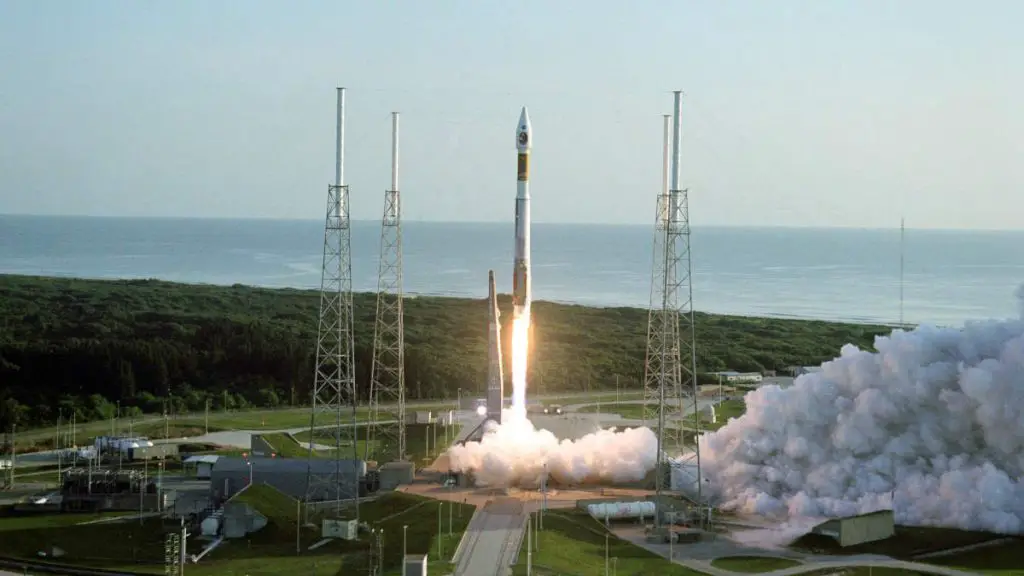On August 12, 2005, Mars Reconnaissance Orbiter was launched from Cape Canaveral, as part of NASA’s Mars Exploration Program. MRO is a multipurpose spacecraft designed to conduct reconnaissance and exploration of Mars from orbit. The orbiter played a crucial role in advancing our understanding of the Red Planet, both in terms of current conditions and its history.
August 12 story of what happened this day in Science, Technology, Astronomy, and Space Exploration history.
Mars Reconnaissance Orbiter
The Mars Reconnaissance Orbiter (MRO) was launched from Cape Canaveral, Florida on top of an Atlas V launch vehicle on August 12, 2005, at 11:43 UTC. The spacecraft reached Mars and entered orbit on March 10, 2006, at 21:24 UTC. In September 2006, after six months of aerobraking, it entered its final science orbit and began its primary science phase.
On September 29, 2006, the orbiter took its first high-resolution image from its science orbit. This image is said to resolve items as small as 90 cm (3 feet) in diameter.

What Occurred During Mars Reconnaissance Orbiter Launch – Launch steps
Many people think of lift-off as the launch, but there were actually several steps during the launch phase.
- Countdown and systems checks
- 0:00: Lift Off through Atlas Stage 1 Booster, which accelerated the spacecraft to supersonic speeds of about 4,500 meters per second (10,000 miles per hour or around 16,000 km/h)
- 4:03: Booster Engine Cut-Off for the Atlas Stage I Booster
- Atlas Stage I Separation from the Centaur Stage II; Atlas fell back to Earth into the Atlantic Ocean
- 4:19: Main Engine Start of the Centaur Stage II
- Centaur First Burn Phase, which lasted nine-and-a-half minutes, boosted the spacecraft into a “parking orbit” in which the spacecraft and Centaur coasted for about 33 minutes between the first and second Centaur burns
- 4:27: Jettison of the Payload Fairing, which fell back to Earth into the Atlantic Ocean
- 13:52: The main engine Cut Off for the Centaur First Burn
- 49:51: Centaur Second Burn Phase, which lasted about 10 minutes, accelerated the spacecraft out of Earth orbit and set it on its way to Mars
- 55:21: Main Engine Separation of the Centaur Stage II
- 58:10: Centaur collision avoidance maneuver, which ensured that the Centaur did not get in the way of the spacecraft or assume a flight path that would cause it to eventually impact Mars
- At this point, the launch phase ended, and the spacecraft continued in its cruise phase.
Video: The launch of Mars Reconnaissance Orbiter (MRO)
Mars Reconnaissance Orbiter Mission objectives
The formal science objectives of MRO are:
- Observing the present climate, particularly its atmospheric circulation and seasonal variations of Mars.
- Searching for signs of water, both past and present, and understanding how it altered the planet’s surface.
- Mapping and characterizing the geological forces that shaped the surface.
The two mission support objectives are:
- Providing data relay services from ground missions back to Earth.
- Characterizing the safety and feasibility of potential future landing sites and Mars rover traverses.
The Mars Reconnaissance Orbiter (MRO) played a key role in choosing safe landing sites for the Phoenix lander (2008), Mars Science Laboratory / Curiosity rover (2012), InSight lander (2018), and the Mars 2020 / Perseverance rover (2021).
Instruments Onboard:
- HiRISE (High-Resolution Imaging Science Experiment): This powerful camera can capture detailed images of the Martian surface, allowing scientists to view features as small as a coffee table.
- CRISM (Compact Reconnaissance Imaging Spectrometer for Mars): This instrument studies minerals on Mars’ surface and has been key in identifying past water-related activity.
- MCS (Mars Climate Sounder): This probes the atmosphere to study the climate and weather.
- MARCI (Mars Color Imager): A weather camera that provides global daily weather updates.
- SHARAD (Shallow Subsurface Radar): This radar probes beneath the surface, seeking out layers of ice, water, and rock.
- CTX (Context Camera): Works alongside HiRISE, capturing wider, less detailed images to provide context for the high-resolution ones.
As of August 2023, MRO remains operational and continues to send valuable data back to Earth, playing a pivotal role in our ongoing exploration and understanding of Mars.
Sources
- Mars Reconnaissance Orbiter on Wikipedia
- Mars Reconnaissance Orbiter on the NASA Mars Exploration website
- Mars Reconnaissance Orbiter Mission Overview on the NASA Mars Exploration website
- Mars Reconnaissance Orbiter Mission Page on the NASA Mars Exploration website
- Mars Reconnaissance Orbiter on the NASA Jet Propulsion Laboratory website
- Moon Landings: All-Time List [1966-2025] - February 2, 2025
- What Is Max-Q and Why Is It Important During Rocket Launches? - January 16, 2025
- Top 10 Tallest Rockets Ever Launched [2025 Update] - January 16, 2025
